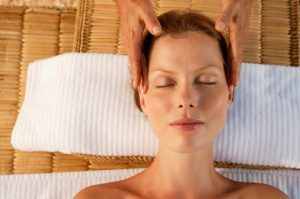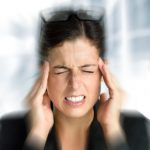 Chronic migraine headaches affect nearly seven million Americans, so there is a strong need for natural treatment. A migraine headache is described as a headache that occurs more than 15 times within a month, unless it is an episodic migraine, which can occur less often. A migraine headache can last four hours or more and are often associated with depression, anxiety, sleep problems or other issues.
Chronic migraine headaches affect nearly seven million Americans, so there is a strong need for natural treatment. A migraine headache is described as a headache that occurs more than 15 times within a month, unless it is an episodic migraine, which can occur less often. A migraine headache can last four hours or more and are often associated with depression, anxiety, sleep problems or other issues.
A migraine headache can be quite debilitating; people often become sensitive to light and sound and can even become nauseas and vomit. Because of the effects of migraine headaches, and how often they can occur, it often keeps people away from work and other responsibilities as they simply cannot function normally while experiencing a migraine headache.
Although there are therapies to treat migraine headaches, these are often not effective at preventing future migraine headaches and simply lessen the symptoms associated with active migraine headaches.
Advertisement
The World Health Organization has categorized migraine headaches as being on the same level of disability as dementia, quadriplegia and acute psychosis.
Chronic migraine facts
 Nearly one in four American households has a person who suffers from chronic migraines. Over 12 percent of the population – including children – experience chronic migraines; more people suffer from migraine headaches than diabetes and asthma combined. Women typically suffer more from chronic migraines than men, and migraines tend to run in families.
Nearly one in four American households has a person who suffers from chronic migraines. Over 12 percent of the population – including children – experience chronic migraines; more people suffer from migraine headaches than diabetes and asthma combined. Women typically suffer more from chronic migraines than men, and migraines tend to run in families.
Chronic migraines are the eighth most disabling illness in the world; roughly every 10 seconds someone in the U.S. is experiencing one. Nearly 90 percent of migraine suffers are unable to work or attend school.
Although from time to time we experience a normal headache, which can be a nuisance, a migraine headache is much different. A migraine contains many neurological symptoms and can be accompanied by light and sound sensitivity, nausea, vomiting, tingling or numbness in extremities and dizziness.
Alternative methods to treat chronic migraine headaches
 Alternative treatment methods for chronic migraine headaches have been shown to offer supplementing relief alongside traditional methods. Here is a list of alternative methods worth trying to treat chronic migraine headaches.
Alternative treatment methods for chronic migraine headaches have been shown to offer supplementing relief alongside traditional methods. Here is a list of alternative methods worth trying to treat chronic migraine headaches.
- Acupuncture: Hair thin needles are inserted into the skin at designated points in order to offer relief from pain.
- Biofeedback: This involves becoming aware of changes in muscle tension, heart rate and skin temperature. By recognizing these changes you can take medication earlier or other preventative methods.
- Massage: Massage can help alleviate stress and muscle tension.
- Herbs, vitamins and minerals: There is some evidence that some herbs, vitamins and minerals may be beneficial in the treatment of chronic migraine headaches. Always speak to your doctor before taking supplements and herbs to avoid complications and medication interactions.
- Electrical stimulation of the occipital nerve: A battery-powered device is implanted near the occipital nerve located at the base of your neck. Continuous energy pulses are then sent to this nerve.
- Essential oils: Aromatherapy utilizes essential oils to promote relaxation and reduce stress. Some evidence supports the scents of ginger, peppermint and lavender can ease migraine headache pain.
- Dietary changes: For some people, food can trigger migraine headaches. Common trigger foods are chocolate, aged cheese, citrus fruits and red wine. To determine what your food triggers are, keep a food diary for a month and report when you experience a migraine.
Natural relaxation techniques for migraine headache relief
 A person who suffers from chronic migraine headaches can benefit from relaxation. A few different methods which can help promote relaxation are:
A person who suffers from chronic migraine headaches can benefit from relaxation. A few different methods which can help promote relaxation are:
- Rhythmic breathing: We typically breathe quickly because we are often in a rush. Rhythmic breathing entails slowing down your breath. Inhale for counts of five and exhale for counts of five until you can breathe that way without counting.
- Deep breathing: When we breathe quickly we also breathe shallowly. For deep breathing, inhale to completely fill your abdomen and then exhale to let it all back out.
- Visualized breathing: This method is best done with your eyes closed, imaging the tension in your body being released with every exhale.
- Progressive muscle relaxation: Turn your thoughts onto your body – picture your headache or other pain and focus on relaxing those body parts to release the pain.
- Relax to music: If you need an aid in relaxation, calming music can be used.
- Mental imaginary relaxation: Imagine relaxing scenarios like a park, a warm spring day or even a beach. Whatever image relaxes you, picture it.
Steps to avoid migraine pain naturally
Prevention is also a large part in treating migraine headaches. Here are tips to help prevent migraines from occurring or at least lessen their impact.
- Find a calm environment – turn off the lights, apply cold compresses on your neck and head
- Sleep well – establish regular sleep hours, unwind at the end of the day, minimize distractions, check your medications
- Eat wisely – document meals in a food diary to find food triggers, don’t skip meals, avoid trigger foods, eat consistently
- Exercise – often and at the level recommended by your doctor
- Manage stress – don’t rush, finish assignments early, make to-do lists
- Keep a migraine diary – learn triggers, patterns, causes
- Strive for balance – meditate, practice yoga, stay calm
Related Reading:
Migraine headache severity linked with LDL and total cholesterol levels
According to new research a link has been made between severe migraines and LDL and total cholesterol. An estimated 37 million Americans suffer from migraines, and about two to three million of those sufferers experience chronic migraines. Continue reading…
Advertisement
Blood pressure drug to treat migraines
Migraines are a painful problem that can interfere with everyday life, leaving many holed up inside with the curtains drawn when migraine strikes. Treatment drugs currently on the market may not be effective, but a recent discovery may help to provide relief from the pain and vision issues. Continue reading…
Sources:
http://www.healthline.com/health-slideshow/relief-from-chronic-migraine
http://www.migrainetrust.org/chronic-migraine
http://www.healthline.com/health/migraine/chronic
http://www.migraineresearchfoundation.org/fact-sheet
http://www.mayoclinic.org/diseases-conditions/chronic-daily-headaches/basics/alternative-medicine
http://www.webmd.com/migraines-headaches/stop-frequent-migraines
http://www.webmd.com/migraines-headaches/guide/relaxation-techniques
http://www.mayoclinic.org/diseases-conditions/migraine-headache/in-depth/migraines

